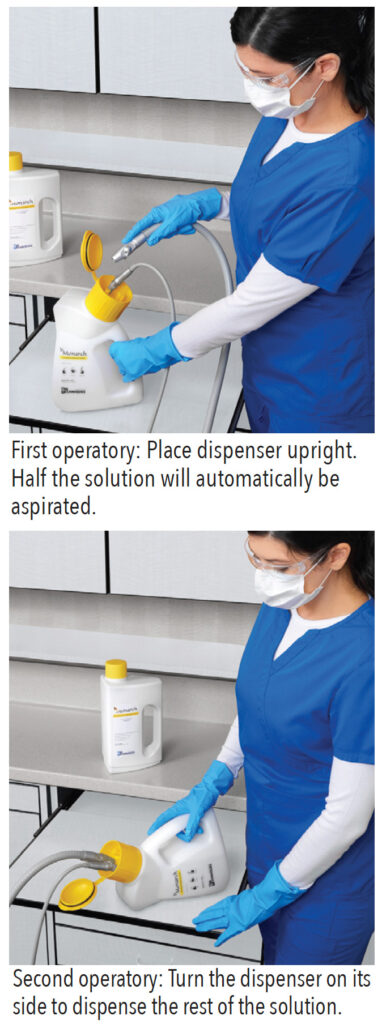Part Two: Do You Know Your Lines?
Keeping evacuation lines clean is key to safe patient care.

Right: Saliva ejector plus HVE Air Protect XL
Aerosols are generated during many dental procedures; they can travel several feet and remain detectable in ambient air for up to 30 minutes. The dental aerosol, or spray mist cloud, contains treatment water, blood, saliva, a variety of microorganisms, and solid particles such as tooth substance and dental materials. Ensuring proper dental vacuum function with sufficient air flow to remove fluids and mitigate aerosols is vital during patient care. Utilizing an intraoral high-volume evacuator with a vacuum system providing a flow rate of around 10 SCFM can reduce aerosols to an undetectable amount.
When evacuation lines are not cleaned regularly or properly, the debris can solidify in the lines. This will restrict the air flow from the vacuum and lead to poor suction and insufficient aerosol reduction. It is possible that the buildup can become so significant that the air flow becomes completely blocked. Also, unclean evacuation lines can generate a nasty smell. Yes, they can stink!
 In its final rule for amalgam separators, the US Environmental Protection Agency states that vacuum lines must not be cleaned with products that have a pH below 6 or higher than 8, or contain any oxidizing agents such as bleach, chlorine, iodine, or peroxide. Choosing a quality cleaning solution and implementing a protocol for keeping lines clean are imperative to maintaining safe evacuation lines.
In its final rule for amalgam separators, the US Environmental Protection Agency states that vacuum lines must not be cleaned with products that have a pH below 6 or higher than 8, or contain any oxidizing agents such as bleach, chlorine, iodine, or peroxide. Choosing a quality cleaning solution and implementing a protocol for keeping lines clean are imperative to maintaining safe evacuation lines.
A quality evacuation line cleaning solution has the following characteristics: safe to use and be around, non-foaming formula, neutral pH, can be premixed, maintains effectiveness for several days, excellent cleaning efficiency, easy-to-mix liquid, able to be used with wet or dry vacuum systems, fresh scent, and cost efficient per use.
Using an engineering device that adds air to the cleaning solution to create a vortex effect allows the solution to cover the entire 360° of the evacuation lines. On the other hand, the dip-and-slurp bucket method provides no spinning of the solution, prevents consistency from one clinician to the next, requires oversight, and either necessitates too much or not enough solution. Also, if the evacuation lines are just dropped into a bucket, the solution can travel at a speed up to 25 miles per hour. When the fast-traveling liquid comes to the end of the line, a water hammer is created that can damage the vacuum. The engineering device should be easy and safe to move without any splashing or spillage, allow for hands-free dispensing, enable the precise measurement of liquid to be dispensed, and be simple to close and store.
In summary, cleaning the evacuation lines—at least at the end of each workday—with a non-foaming cleaner and a dispensing system that atomizes and spins the solution is essential to maintaining the vacuum system’s air flow for optimal aerosol mitigation. When choosing an evacuation line cleaner, safety, regulatory compliance, cost, and ease of use are important considerations. n
Air Techniques
airtechniques.com
800-AIR TECH
From Dimensions of Dental Hygiene. October 2022; 20(10)26.

